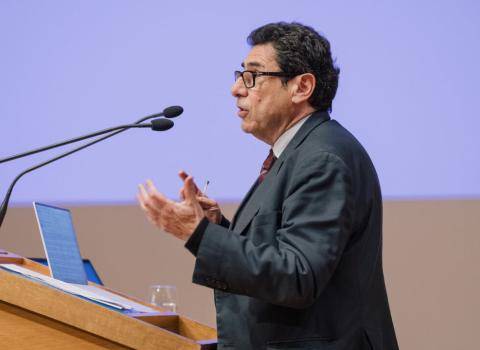Last fall, I took nine educators to Ukraine to study the Chernobyl catastrophe of April 1986. We learned of Ukraine’s ongoing work to manage the ruins of the Chernobyl reactor and its efforts to build a 21st century energy economy. In talking with many Ukrainians, we were struck with two points: First was the shear multitude of issues connected to energy, especially technology choice, climate change, water, economics, foreign policy, politics, and public understanding; and second were the difficulties of reaching consensus. American participants saw that looking at Ukraine helped them grasp the magnitude of similar challenges at home.
In the U.S., climate change from using fossil fuels and insecurity of oil supplies rank high on the list of public concerns. However, apart from the engineers and scientists who study energy, not many Americans can speak knowledgeably about our reliance on fossil fuels, the dangers posed by climate change, or the connections between energy and international conflicts. Even many of those who advocate for clean, renewable fuels would be hard-pressed to explain the steps needed for wind and solar power to replace coal or for plant-based biofuels to replace gasoline and diesel. Many may not realize that coal, petroleum, gas, and nuclear power today comprise 95 percent of the U.S. energy supply.
“Energy literacy,” in other words, is low, far too low. Only with higher energy literacy can we mobilize the political and economic will to reduce uses of fossil fuels, a task with staggering challenges. America’s educational institutions have work to do.
Some universities and colleges have a good course or two; a few even have excellent programs. Effective energy education, however, needs to be far more widespread, reaching more students and more geographic regions.
Moving away from fossil fuels requires remodeling the energy infrastructure. If the pathways to new energy practices were self-evident, then the problems would be easy. Troubles begin when we ask (a) what is to be done? (b) how shall we decide? and (c) which new investments will provide the best transition to the use of new technologies?
Many alternatives to fossil fuels exist. Nuclear power is the next largest source of energy after petroleum, coal, and gas in the U.S. Biofuels, wind, solar, and other renewables provide the smallest amount of energy but offer high future potential. The problem is that choosing the best new technologies is not so simple. The crux of the problem lies in the fact that people embrace conflicting choices. A solution that looks ideal to some will look like bad judgment or even a nightmare to others.
The U.S. currently has no consensual methods for making energy choices, yet these decisions carry enormous investment and public policy implications. The world needs $15 trillion every 40 years to rebuild energy infrastructure, or $375 billion each year for two generations. As the world’s population grows and more poor countries become richer, the yearly investment needed will grow.
Citizens must participate in complex energy choices. It is not enough to leave the matter to technical experts or the operations of a supposed free market. Technical experts have absolutely indispensable knowledge, but choices of technology also affect wealth and its distribution, politics, risks, land use and environmental quality, and ethics. In addition, many policies and subsidies for all energy sources mean that no truly free market in energy exists. The most important decisions will occur in the political arena, and citizens have both the right and the obligation to participate
Building effective citizen participation requires educational resources that don’t currently exist. At the very least, universities and colleges need two specific kinds of courses: (1) general education that explains the current energy economy, its strengths and weaknesses, the potential and reasons for change, and how democracies can design transition pathways; (2) advanced courses and internships in relevant fields to prepare students for professional level work with industry, government, and non-profits.
Universities ultimately need to offer more than general education and advanced courses. As many have noted, energy will be a defining issue of the 21st century. Commensurate with this challenge, educational institutions should see “energy studies” as a field in its own right. Students need a better understanding of energy’s multiple dimensions instead of highly fragmented knowledge taught in different schools and departments that do not communicate well. This unification is essential for building sustainable energy systems.
My own teaching experience, reports from other colleagues, plus studies from student groups indicate that, if offered, energy education will meet with enthusiastic student support. More importantly, it will help to raise energy literacy so that citizens can intelligently evaluate the staggering challenges of our global energy future.
John H. Perkins is a senior fellow at the National Council for Science and the Environment, a visiting scholar at the Energy Biosciences Institute, and an emeritus member of the faculty of The Evergreen State College where he developed and taught an intensive curriculum of energy studies.
This article first appeared in the Spring 2011 issue of Bioenergy Connection magazine.





 A unique international forum for public research organisations and companies to connect their external engagement with strategic interests around their R&D system.
A unique international forum for public research organisations and companies to connect their external engagement with strategic interests around their R&D system.